You needn't be a diver to appreciate the stunning underwater images gracing magazines and the internet. As a photographer, our challenge is to bring those colors out in a natural, vivid way without using the saturation slider in post-production. Now that we understand lighting a little bit better, it's time to apply some of those principles. Here, we will discuss some specific shooting techniques to get a black or blue background in our macro images.
Black background
We can shoot an image with a black background in the following ways:
- The subject has nothing behind it but water
- Using a low ISO speed of 100
- Using a high shutter speed — 1/200 for a DSLR or 1/500 with a compact camera
- Our f-stop is stopped down to a higher number, which means a smaller aperture. For a compact camera use f/8. On a DSLR use f/16 to 18 or higher.
As discussed in our last installment, we create a barrier from ambient light by using the low ISO and a fast shutter speed. This allows for stronger, natural contrast through strobe saturation. Think of the image as two separate parts, treating the background and foreground differently.
For the background, the ISO and shutter speed work together. Once you set this, you can leave it alone. The shutter speed — unless you're shooting under 1/30 — has nothing to do with image sharpness. You'll dial this in with the strobe-flash duration, which will freeze the action instantly. So, keep your shutter speed fast and your ISO low for the background. For the foreground, concentrate on adding the colors by nearness to the subject, strobe angle and f-stop.
When shooting a subject with a black background, the key is to avoid flashing the strobes into the background itself. Instead, angle the strobe head. Imagine going through all the work of preparing to paint a wall in your house and then simply throwing a bucket of paint on it and walking away. Sloppy painting like this would negate our meticulous preparation. Now apply that metaphor to creating an image with a black background.
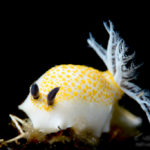

Shot selection
Shot selection is 80 percent of creating an image with a black background. Simply find a subject that is perched on a rock, hanging out of a crevice, hiding in a vase sponge, or is relatively static. Nudibranchs are an easy subject to use for practicing composition on a black background. Be sure nothing is behind your subject and get low. Get close and shoot at an upward angle.
Strobe placement
To avoid over-lighting the background, change your strobe angle so that the strobe heads are facing inward. Not at each other or at the lens port, but in an "x" configuration. If you're using two strobes, the right strobe head should face your 8:00 and the left should face the 4:00 o'clock.
Remember that the strobe-flash pattern is cone-like. Think of the emitted light leaving your strobe and spreading out as it gains distance from the strobe. We want to use the outside edge of that strobe-flash pattern to illuminate our subject. This strobe angle works best for subjects that are at the closest inner-working distance of your lens (3 to 4 inches).
You can use that same strobe angle for super-macro. The idea here is for your camera housing to block most of the light emitted, with just enough light to gently kiss your subject. Preparing your shot with a fast shutter-speed and low ISO, as well as applying these strobe-flash techniques will result in a colorful image with lovely contrast on a black background.
Other considerations
Of course, there are a few other considerations, chief among them the problem of backscatter. When the strobe flash illuminates particulates in the water between the lens port and the subject itself, you've got backscatter. Your focus light won't cause backscatter as the strobe flash is stronger. Avoiding backscatter using the "x" strobe-angle technique takes practice and problem solving, so keep these points in mind when it appears in your shots:
- Don't aim the strobes at each other in front of the lens port
- Don't aim them at the lens port
- If there's too much backscatter, angle the strobes in further
- Increase your f-stop
- Wait for the water to clear up a little before proceeding
Don't get discouraged; simply adjust, shoot again and check. Keep angling the strobes and work your f-stop up a little until you have success. After a little practice you'll be producing stunning macro images with black backgrounds.
Bringing in the blue
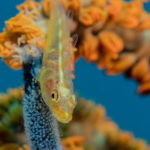
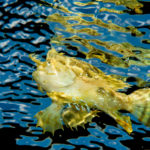
Although a blue (or green) background is common in wide-angle images, it's less so when it comes to macro. But what if our subject is black or a detailed portion of the subject is black? Black on black doesn't work, and no matter how we change the strobe power, nothing seems to work.
Slow your shutter speed
You can bring blue into the background simply by slowing your shutter speed down from 1/200 to 1/60, enough to allow the ambient light to leak in. Slowing your shutter speed this way will allow more light through the aperture and will brighten the background. Keep control tight though, as the sun will ultimately overpower the shutter speed and strobe flash, resulting in a soft leading edge on your subject.
Otherwise you'll use the same technique and strobe positions outlined above. Shot selection, subject, situation and strobe angles can remain the same; the only difference will be a slower shutter speed. Remember that shutter speed controls the ambient light in the background and your f-stop will control the foreground flash. The colors will pop in foreground and the blues will now enter the frame.
Note that if your shutter is too slow, your subject will have a soft edge. These aren't always a bad thing if they are trailing the subject. If the soft edge is on the mouth or eyes then analyze your shot, note the shutter speed and try again. Subjects like frogfish or nudibranchs are easy to practice on and, as your skill progresses, you can challenge yourself with other animals.
Other techniques
To add another technique to your portfolio, you can capture the blur and create a smoky edge on a moving subject. Again, you'll use your shutter speed and f-stop. Logic reverses though, and here we'll control the sharpness with strobe flash, higher f-stops, and shutter speeds of 1/60 for a DSLR. Try to time the shot when your subject for a moment when your subject has nothing behind it, and don't move the camera. Allow the subject to move in the frame; focus on the eye or leading edge and release the shutter.
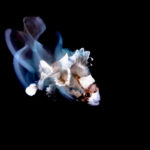
The smoke trail of a fast-moving fish will dazzle your eyes when captured correctly. In this image, I'm using a shutter speed of 1/30, focused on the eye and holding steady. Let the subject move through the frame and resist the urge to follow it. You will actually hear the shatter making a "ca-chunk" sound when it's this slow.
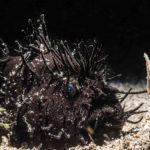
When shooting a black subject on the sand, like this black hairy frogfish, reverse the logic back and open your aperture. There is no need to change the strobe duration. When the aperture is open to f/11 or more, the strobe flash begins to fill in your subject's textures, resulting in a better exposure. I shot this image in full daylight and in shallow water. I used a snoot to restrict the spread of my strobe flash, fast shutter, low ISO and an f-stop of f/9.
The simple rule of photography is that there are no rules. It's your own mastery over your camera — not the camera — that creates appealing images. When it comes to shooting for different backgrounds in your macro images, take your time, experiment often and don't forget to have fun.
By guest author Mike Bartick
The post Shooting for a Black or Blue Background in Macro Images appeared first on Scuba Diver Life.
from Scuba Diver Life http://ift.tt/2FRDZBc
No comments:
Post a Comment